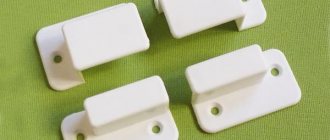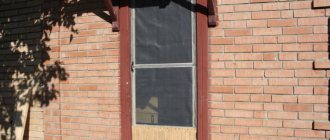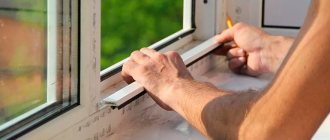When ordering plastic windows, manufacturing companies usually offer to immediately install mosquito nets that protect against the penetration of insects, poplar fluff and dust. But after 1-2 seasons, many notice that in some places holes have appeared where flies and mosquitoes can freely fly in, the frame has broken down, and the handles have fallen off. In this case, you can make a mosquito net with your own hands, especially since suitable materials are available in any hardware or hardware store.
First step: measuring the mosquito net:
The width of the mosquito net frame profile in the vast majority of systems is 2.5 cm, and the net should be placed on the window in such a way that the light opening is covered only by the canvas; the metal frame should be located outside the light opening. Therefore, it is necessary to add 5 cm in height and width to the dimensions of the light opening.
In this case, you need to make sure that there is this distance on the sides.
And in terms of height, you should also take into account the size of the external fasteners. There should be at least 4.5 cm of the window profile on top, and at least 4 cm on the bottom.
If there are caps on the bottom of the window frame that cover the drainage holes, they can be removed. If at the top the frame goes deep beyond the quarter, then it will not be possible to install standard fastenings on top. As an option, you can press the mesh to the window with special rotating fasteners, which are called “lambs” or “flags”. They are placed on the sides of the net.
This method for measuring frame mosquito nets is applicable for plastic windows. For wooden or aluminum windows, as well as for sliding glazing, this procedure does not apply or applies with certain reservations.
Which material to choose
The basis is polymer or natural fabric.
- Cotton has all the necessary properties, but does not tolerate constant humidity. In the middle zone it is rarely used.
- Nylon is an anti-allergenic material that traps dust and pollen well.
- Polyester - it does not have special properties. Lasts a long time in any climate. It is durable and not afraid of dampness.
- Fiberglass - as the name suggests, the material has the properties of glass. It is almost transparent and has very high strength. This fabric does not tear and lasts a long time. It is often used on the upper floors if pets live in the apartment. The canvas can easily support the weight of a cat.
Plastic, metal and wood are used to create the frame. The latter option is specially created for wooden double-glazed windows and is quite rare. Metal products have the greatest strength.
Assembling a mosquito net with your own hands.
To assemble a mosquito net, you first need to purchase the necessary set of materials.
What you need to have to assemble a mosquito net, materials and tools:
1. Aluminum frame and crossbar profile (impost). 2. Plastic or aluminum corners for connecting frame profiles. 3. Metal connectors for the mosquito net impost. With the help of such fastenings, the crossbar clings to the frame. The crossbar in the mesh is needed so that the geometry of the frame is not disturbed during manufacturing. Without an impost, the size in the middle of the mesh is reduced from 10 to 25 mm depending on the size due to the tension of the web. 4. Special mosquito cloth. 5. Rubber cord to hold the canvas in the frame. 6. Plastic or metal handles for installing and removing the mesh. 2 pieces. 7. Miter saw or hacksaw to cut the profile to the required size. 8. You will also need a tape measure and a pencil to mark the profile for cutting. 9. We also recommend using a metal file to remove burrs on the profile after cutting. Otherwise, difficulties may arise with inserting corners into the profile. 10. A hammer with a plastic or rubber striker for attaching connecting corners to the mosquito net profile. 11. An ordinary stationery knife, which you will use to cut off the excess fabric around the perimeter. 12. Slotted screwdriver for sealing the rubber cord into the profile groove. For convenience, you can buy a special tool - a roller for rolling up the cord of a mosquito net. You can purchase all components for assembling the mosquito net in our online store. Kits for assembling mosquito nets are available for sale.
The procedure for making a frame mesh
1. Cut the frame profile with a hacksaw or miter saw. Calculate the size as follows. Determine the external overall dimensions of the future finished mesh. Subtract 60 mm from the height and width of the mesh. 2. Cut off the crossbar profile by subtracting 50 mm from the width of the finished mesh.
Example. If the finished mesh has a size of 600x1600 mm, then the frame profile needs to be cut 540 mm and 1540 mm in two pieces. The crossbar for a finished mosquito net 600 mm wide will be 550 mm long.
3. Bring the profile into the corners, and with a light tap of the hammer, assemble the rectangular frame of the mosquito net. 4. Place the mosquito cloth on the frame so that it protrudes beyond the edges of the frame by 30–40 mm. 5. Using a slotted screwdriver or the back of a utility knife, thread the rubber cord into the profile groove on top of the blade. In this case, it is necessary to ensure that the canvas does not gather in folds or wrinkle. 6. Installation of handles. This can be done either immediately while rolling up the cord, or then, by lifting the cord at the place where the handle is installed, put it down and roll up the cord again. 7. The last step is to carefully trim the mosquito cloth protruding beyond the frame with a sharp stationery knife.
Popular types of insert mesh for plastic windows
The choice of mesh sheets for protecting windows and doors from annoying mosquitoes is quite large. Of all the variety, the most popular models can be noted:
- frame design. It is the most affordable and simple, can be sliding or removable. If the window opening area is large, a mosquito net with an additional reinforcing strip in the middle is installed;
- mesh mounted on plungers directly into the window opening. Its advantage is higher resistance to environmental factors. For example, strong gusts of wind;
- Velcro mesh. A popular model among those buyers who do not require constant protection from flying insects. Such protection can be removed at any time without outside help;
- mosquito net mounted on hinges similar to the door opening. The closed position of the structure is ensured by special magnets;
- roll type mesh. According to the principle of operation, it resembles roller curtains. The canvas is unwound and collected back into a box installed above the window opening;
- pleated mosquito net. This is also a roll type of construction, but it is assembled in a horizontal plane (by analogy with an accordion). The advantages of such meshes are a wide range of colors, the ability to decorate the canvas with decorative elements and patterns.
Installation of mosquito net
Tools and materials for installing a mosquito net yourself
You will need: • a screwdriver or drill; • mosquito net fastenings and self-tapping screws with a drill • if the screws are without a drill, then you need a 3mm drill for metal • pencil
Procedure for installing a mosquito net.
Even if you couldn’t find the materials to make a mosquito net and bought a ready-made one, you can easily install it yourself with your own hands. To do this, we suggest proceeding as follows: 1. Attach 2 lower Z-shaped fasteners to the bottom of the window profile from the street side (they are smaller in size than the upper ones) and indicate the points for drilling with a pencil. Drill the profile and tighten the screws with a drill, screw size 3.9x16 or 3.9x19 mm.
To make the process easier, you can first glue the z-shaped fasteners to the window profile with double-sided tape, try on the mesh, and only then drill it.
2. Before tightening the screws, we recommend treating the connection with silicone sealant. 3. Attach the mesh to the outside of the window, installing it on the lower fastenings, and carefully check all dimensions again. 4. At the top of the window profile on the street side, install the top z-shaped fasteners. Here double-sided tape will help you out again. First, attach the fasteners to it and then, with your hands free, tighten the screws. The easiest way to determine where they are installed in height is to mark with a pencil the top of the mesh installed on the lower mounts. You can go the hard way and calculate mathematically - the size from the supporting part of the lower bracket to the supporting part of the upper bracket should be 8 mm greater than the height of the mosquito net. 5. Having installed all the fasteners, take the mosquito net by the handles and hang it out the window. First, lift the mesh and insert it into the seat of the upper fasteners until it stops. With correct calculations, the bottom of the mesh should pass almost flush over the lower fasteners. Then lower the mesh down onto the lower fasteners. Check whether it is firmly held in the grooves of the fasteners. If not, then you need to lower the upper fasteners to secure the mosquito net more tightly.
Video on assembling a mosquito net with your own hands
Movable mesh doors on guide rails
Movable panels with anti-mosquito fabric are installed to protect openings with sliding glazed frames. Modern plastic sliding systems are equipped with factory-made MS. The protective screens have rollers in the upper and lower transverse bars of the mesh.
Movement of the MS along an additional guide rail
Step-by-step instructions for installing a movable mosquito net
If the sliding window system has been installed for a long time, you can make a movable frame with a mosquito net yourself. You need to do it like this:
- Sections of the cable channel without covers are glued to the window sill and ceiling close to the guides of the sliding system. To do this, it is better to use Liquid Nails glue.
- You can make a mosquito net yourself or order it according to the measurements of the window opening. The frame can be made of wooden slats with a width equal to the groove of the cable channel;
- An adhesive tape is glued or stapled onto the vertical elements (it is used in wardrobes and is commercially available). The brush seal is needed in order to eliminate the slightest gaps on the sides of the mesh;
- For ease of handling, handles are screwed onto the vertical bars of the mesh;
- Carefully bending the sides of the guides at the top and bottom, insert the mesh into the channels. The protection is installed and ready for use.
- In order not to deform the plastic box each time, you can install spring-loaded rollers, which are mounted in the doors of sliding wardrobes.
DIY mosquito net
DIY mosquito net
Summer brings not only positive emotions and relaxation, but also annoying flies, nasty moths and hated mosquitoes that try to fly into an open window. A mosquito net is inexpensive, but if you count how many windows there are in the house, you end up with quite a decent amount. Do-it-yourself mosquito nets will really save your money.
Buying a window mesh will cost you about 1,500-2,000 rubles, so to save money, you can make it yourself. Many people wonder how to make a mosquito net for a window? This is not difficult, especially since everything you need can be bought at a hardware store. If you are interested in the question of what mosquito nets are made of, then the answer is simple - the material is durable fiberglass with the addition of weather-resistant PVC. The higher the quality of the material, the higher the protection against insects.
Before making a mosquito net with your own hands, take careful measurements and do not forget about allowances. If you are going to attach the mesh using Velcro or glue, choose something that can be easily removed and will not damage the window.
There are several mosquito nets that you can make yourself.
- Secured with fastening tape is a simple and cheap way to make your own mosquito net.
- Frame.
- Rolled.
One of the easiest ways to make a mosquito net with your own hands is using special material and adhesive tape.
Take high-quality Velcro; the quality of fastening the protective mesh to the window opening will depend on this. You will also need special material with small cells. The smaller the cells, the better. This material can be purchased at fabric stores, or you can use old products, for example, unnecessary tulle. It is best to purchase a special mosquito net - it reliably protects against insects and withstands weather conditions.
After all measurements have been taken, take the material and cut it out, do not forget to leave small allowances. Divide the Velcro into two equal parts. Apply glue to one part and carefully glue it to the window opening. After the glue has dried, attach the mosquito net to the adhesive tape. Similar nets can be made for a car. It is done quickly and easily, with minimal costs. Instead of adhesive tape, you can use special magnets; this will significantly reduce the installation time of the mesh and simplify the process.
A more expensive and complex method of making a mosquito net is the method with fastening to a frame. To do this you will need metal corners, a plastic cable and pop rivets.
The first thing you need to do is measure the window from the outside, because this is where the mosquito net will be attached. Cut the cable to the required length, maintaining an angle of 45 degrees. Sand the sections and connect them using metal corners. Now make holes in the corners in which the rivets will be located. They should be on the outside, not inside the cord. Now all that remains is to attach the mosquito net itself to the frame. Do not pull the mosquito net too tightly, as this can deform or tear the fabric.
You can make sliding mosquito nets with your own hands; they will fit well and protect the balcony opening or front door. A mosquito net for your balcony will help you prevent dangerous insects from entering the room and will reliably protect you even from street dust. The manufacturing technology is the same, the only difference is that the material is cut in the middle and the edges are processed. For convenience, you can attach magnets or rivets to the edges of the mesh, thus providing additional protection.
Rolled window mesh operates on the principle of roller shutters. It will reliably protect against insects, and it is convenient and easy to use. If you are interested in how to assemble a rolled mosquito net with your own hands, then there is nothing complicated here. You just need to be patient and have the appropriate materials.
You can make a mosquito net for a window of any size with your own hands. To make a rolled protective mesh, you only need a special box with a shaft and material. To attach the mesh to the window, use special magnetic latches. You can use screw fastening with an overlap or at the end of the guide in the opening to the slope. It is more convenient to use a rolled mesh than a regular one, and it is much easier to care for.
A rolled-up mosquito net for a window is an excellent protection against annoying insects. Allergy sufferers will especially appreciate this design - after all, it will protect the room not only from mosquitoes, but also from plant pollen and poplar fluff. It is best to choose a fine-grained material for such a mesh, this will increase the level of protection.
Making a mosquito net with your own hands is not difficult. If you need a mosquito net for a balcony or window, you can make it yourself quickly and at no extra cost. Give this process some time and enjoy a quiet life without annoying insects! A homemade mosquito net is quite inexpensive. After summer, you can remove it from the window and carefully pack it, and hang it on the window again next year.
Which mosquito net is better?
Fiberglass, polyester, polyester or nylon threads are used to make the fabric. To provide resistance to solar radiation, UV stabilizers are added to high-quality raw materials. If they are not there, the polymer fabric will quickly collapse under the influence of ultraviolet radiation.
The main grid parameter is the cell size. The smaller it is, the greater the amount of dust and insects that can be retained. But at the same time, the flow of fresh air into the room is reduced, so a cell with a side of 1-1.2 mm is considered optimal.
For areas near bodies of water where there are a lot of small midges, as well as for protection from allergens - dust and pollen - such a mesh is too unreliable. We can recommend a cell of 0.6-1 mm, which will be a more effective barrier against the unwanted “joys” of nature. A combination of a mesh and a fumigator or repellent spray works very well, with which the entire surface is sprayed if necessary.
To produce a mosquito net with an anti-cat effect, reinforced vinyl threads coated with polyester are used. They can withstand heavy loads, and there are practically no marks left by the animal’s claws.
Anti-mosquito net Red cat
The color of the mesh does not affect its ability to protect against insects, but it does change the light output, making it brighter and more colorful. If this does not contradict the owner’s feelings, you can install pink, yellow, blue canvases, but light gray has the most neutral properties. It does not distract the eye and allows you to observe the picture happening outside the window without visual distortion.
Of course, the mesh should not emit unpleasant chemical odors that indicate its unknown origin. The threads must be of uniform thickness and the cells of the same size. Although such an accessory is not subject to mandatory certification, every consumer has the right to request an examination from Rospotrebnadzor if signs of poor-quality production are suddenly revealed.
How to make a mosquito net for a plastic window using improvised materials with your own hands
As the famous classic wrote:
Oh red summer! I would love you
If only it weren’t for the heat, the dust, the mosquitoes, and the flies...
Couldn't have said it better! Apparently the poet also faced the problem of annoying insects. Most likely, these poetic lines came to Alexander Sergeevich on a stuffy summer night with a buzzing swarm of blood-sucking insects. Which of us has not found ourselves in such a situation? Who, at least once in their life, has not had to spend the whole night waking up from an annoying buzzing sound, in fear of being bitten and scratching all night and the whole next day?
Of course, all inventive humanity has not stood still since the time of A.S. Pushkin. Fortunately, a huge variety of different means and devices have been invented to repell mosquitoes, flies and other harmful insects.
Various mosquito nets, sprays, ointments, catchers, barriers, repellers, etc., etc.
In our case, we will talk about perhaps the most reliable way to protect yourself from insects in the summer - making a mosquito net for the window. In short, make sure that the enemy does not enter our home.
Of course, now all plastic windows or doors are equipped with similar factory-made devices. But believe me, there are times when such a useful addition is missing for some reason, and then your summer vacation can turn into complete hell. There are situations when there is nowhere to buy even a regular mosquito net (mosquito net).
We will try to make mosquito protection at home, with our own hands from improvised means.
We will use a plastic corner (profile for tiles) as a frame.
You can use other materials at your discretion. And a piece of an old tulle curtain will serve as a mosquito net. The main thing is that the holes in the material are small and do not let harmful insects through.
First, measure the inner perimeter of the window. It is important that the frame fits tightly to the window frame from the inside. We cut our corner in the places where the bending angles of our frame will be, so that it is easier to bend the plastic in the place we need.
And then we form a frame from our corner - which should fit tightly inside the window frame. We fasten the free ends of the frame - the corner - with ordinary tape so that it does not fall apart.
Now we attach a piece of tulle to our frame.
You can attach it to the frame using ordinary pins.
The main thing is that our mesh covers the entire opening.
For greater reliability, so that the fabric does not fly off the corner, you can sweep our tulle around the perimeter with thread.
We install our structure in the window frame.
If the height of the window is large, you can seal the fit of the frame with an additional transverse insert (bar). It will press the longitudinal edges of our rectangle for greater reliability. But in practice, the design perfectly performs its protective functions without any additional seals.
The barrier for uninvited night guests is ready.
This will help you get rid of mosquitoes and other insects at home, in a country house outdoors.
This mosquito net can be installed on a wooden window or on a balcony door.
The only drawback is that not every frame design allows you to close the window. You have to remove the mosquito net before closing the window or door. But believe me, this is a small thing compared to the prospect of spending the night under the incessant buzz of blood-sucking aggressors.
We have offered only one of many options for protection against harmful insects, but whether it suits you or not is up to you.
Using an ordinary jar or glass, you can easily catch a mosquito or any other insect (spider, wasp, beetle, butterfly or grasshopper) that finds itself in your apartment (house)
Requirements for mosquito nets
Easy installation
Yandex.RTB RA-1479455-2
The main task of such nets is to create a barrier to the path of insects from the street to the apartment. Based on this, window and door openings of housing for protection against mosquitoes were previously equipped with any mesh material suitable at first glance - gauze, tulle, gauze fabric, fine-mesh steel construction mesh, etc. However, it soon became clear that due to certain factors these materials lose their functionality and require repair or replacement.
There are three types of mosquito nets:
Rolled mesh - good, but expensive
Yandex.RTB RA-1479455-7
- Frame. This is a frame made of metal-plastic profile, on which a mesh is stretched. The mesh is attached to the frame using special fasteners: Z-shaped brackets or plungers. This design is the most common, since at a low price it protects well from insects. The cost of producing a mesh is from 500 rubles per square meter.
- Rolled. They are designed like roller blinds or blinds. A roll of mesh is attached to the top of the window. By pulling the edge, the net is lowered and fixed. When released from the latch, it rises up. An excellent device, but the price is from 4 thousand rubles per square.
- Swing nets. The mesh is stretched on the frame, but the frame is reinforced, with a larger cross-section than a frame mosquito net. It is most often installed on doors - balcony or entrance, but can also be installed on windows. It is attached to a door or window block using regular hinges. To prevent it from opening due to gusts of wind, magnets are built into it. The estimated cost of this type of mesh is about 2 thousand rubles. per square.
Hinged mosquito nets are convenient for doors
Yandex.RTB RA-1479455-3
- Sliding. These are meshes specifically for sliding window systems. They also have a frame on which the mesh is stretched. BUT this frame moves along special guides that are screwed on from the outside. This way it is possible to move the mesh to the place where the sash is open. Sliding - aluminum windows based on the same system
- Pleated. The method of action is similar to the roll one, but it is collected not upward, but to the side. There are two guides - top and bottom, along which the mesh that folds into an accordion moves on wheels.
Pleated mosquito net - original and not cheap
Yandex.RTB RA-1479455-8
As you can see, there are many types. Nevertheless, in 90% of cases frame structures are installed. At a low price, they create a completely normal level of comfort.
How to make a mosquito net with your own hands
If we start the article with the words “economic crisis”, would you be very surprised? It would seem that the global economy and an insect screen for a window cannot be found in the same sentence. But it was the current economic situation in the country that forced many to reconsider their expenses and start saving where possible. For example, you can save on a mosquito net. Moreover, for this you do not need to sacrifice comfort or endure annoying insects. All you need is the desire and time necessary to make a mosquito net with your own hands. Note: only desire and time. No highly specialized knowledge! Because the design of the mosquito net (at least the frame one) is really easy to assemble.
Answering the question of how to make a mosquito net, let’s decide on the necessary components.
1. Frame profile (the future frame of the mosquito net) 2. Impost (as a rule, this is a transverse crossbar used to strengthen the structure, although there is also a vertical impost) 3. Connecting corners 4. Mosquito net is a net designed specifically for installation in mosquito nets structures and designed for outdoor use. As a rule, it is gray in color, with cells 1x1 mm. Some “craftsmen,” when assembling a window mesh with their own hands, advise using thin nylon to reduce the cost of the design as much as possible. But such nets will not last you even a season! If we talk about economical canvases, it is better to use fiberglass 5. Sealing cord for stretching and fixing the mosquito net in the frame 6. 2 plastic handles for convenient installation of the mesh on the window and its removal 7. 4 holders (the easiest way is to use plastic or metal Z- fasteners) 8. Fastening elements (screws)
Lifehack. If you don’t want (or you don’t have time) to look for all the necessary components, you can buy sets of ready-made mesh for self-assembly in our online store.
In addition, you will need the following tools:
1. Hacksaw and file for adjusting the profile dimensions to the dimensions of a specific window 2. Screwdriver for fixing fasteners 3. Scissors/stationery knife 4. Special seaming roller for seaming the sealing cord (alternatively, you can use the back of a screwdriver, scissors, etc. .)
Making a mosquito net begins with measurements. In this regard, we recommend reading an article on how to determine the size of a mosquito net.
Self-repair of frame mesh
When the frame is pulled out of the brackets carelessly or simply due to long-term all-season use, the corners of the mosquito net break. What to do in this case? Of course, you can do the repairs yourself, especially since it’s not difficult to do.
Damage that you will have to fix yourself
The essence of the breakdown is that the profile from which the frame is made is aluminum, while the connecting corners are made of plastic and therefore less durable.
If the plastic corner breaks, it will need to be replaced. You can buy corners from the organization that installed the windows.
The repair instructions are as follows:
- Turn the mesh over to the side where the sealing cord is visible;
Carefully pry up the cord so as not to accidentally cut it.
- Using a knife, carefully pry the seal from the corner where the breakage occurred and pull it out along the entire side to the opposite corner;
We free not only the broken corner, but also the corner joint opposite
- Along the entire side freed from the seal, carefully remove the mesh from the groove;
- From adjacent profiles we pull out a broken corner, and a whole one on the other side;
So a whole corner is put in place of the broken one
- We insert new corners into the profile on both sides so that the groove for the seal on the corners coincides with the groove on the profile;
It will be very difficult to pull out a piece of the old corner from the profile. Therefore, in order not to waste time and effort, push the fragment further inside the profile, and then insert a new corner.
- We stretch the mesh over the groove and insert the seal;
The seal must run smoothly throughout the entire groove without twisting.
- We press the seal along the entire groove with a screwdriver or other thin object.
Actually, at this point the repair can be considered complete, and I hope that these instructions were useful to you.
Our hands are not for boredom...Or the process of making a mosquito net
1. Cut the profile according to the dimensions of the estimated height and width. This is best done using a hacksaw for metal, which allows you to get neat, even ends. We do not recommend using an angle grinder because it leaves burrs, which will have to be removed with a file later.
2. Connect the slats into a frame using corners. If you assemble the mosquito net with your own hands, do it on a flat and durable surface. Assembly on an uneven floor, for example, can lead (and most likely will lead!) to an irreparable distortion of the structure, which, in turn, will make it impossible to install a finished mosquito net in a window/door opening. In addition, when connecting profiles into a frame, it is necessary to ensure that they are perpendicular to each other and that the width and height parameters are observed.
3. Prepare the mesh fabric. Cut it according to the size of the frame, leaving allowances of 3-5 cm at the edges.
4. Secure the mesh in the frame using a sealing cord Anyone who has already assembled a mosquito net for a window with their own hands will probably agree with us that this is the most painstaking stage of the work. Not everyone manages to stretch and fix the canvas in the frame the first time. But, as they say, patience and work (as well as the desire to save money) will grind everything down. It is much easier to compact the seal into the grooves of the profile using a special seaming roller. But if you don’t want to buy it for just the mesh, use any other suitable device.
5. Insert the handles This should be done at the previous stage, when you compact the sealing cord. If you conveniently forgot about the handles, no problem. Pick up the seal in the place where they will be, insert the handles and roll the seal back.
6. Install fasteners The method of fastening will depend on what type of fasteners you choose. Speaking about the most popular z-shaped fastener for frame mosquito nets, we note that the fasteners are fixed at the top and bottom (on horizontal slats) using self-tapping screws 10-15 cm from the corners of the frame. There must be at least 4 of them (2 on each side)
7. The frame mosquito net is ready! Insert it into the window opening and don’t forget to remove it for the winter!
Advantages of using such structures
The main advantages of a mosquito net include some parameters of this design:
- Mosquito nets are very convenient to use. The products are very easy to install and also quickly and easily removed.
- The mesh can be washed with regular soap and a sponge.
- The design looks elegant and neat, so the interior will not be spoiled.
- The mesh perfectly protects the room from the penetration of various insects and even from raindrops. At the same time, the product does not obscure the view from the window and does not interfere with the flow of fresh air.
- The design is quite durable, since the frame includes metal elements and fiberglass.
- The material does not deform and does not fade in the sun.
- The mesh is very compact and if not needed, it can be stored in any convenient place.
DIY mosquito net: advantages and disadvantages
When a person is interested in how to make a mosquito net for a window with his own hands, he wants to know whether the game is worth the candle and how much more profitable a homemade one will be compared to a factory-made net.
Objectively speaking, a self-made plastic mosquito net will indeed be cheaper. With the average cost of a frame mosquito with fiberglass fabric being 1,500 rubles, the cost of the same homemade one will be 800-1,000 rubles. The difference in price will be more noticeable if we are talking about mosquito nets not for one window, but for all windows in an apartment (or house).
But homemade window screens are always inferior to factory ones in quality and aesthetics, which are impossible to achieve at home. In addition, it is likely that a frame mosquito net will not be suitable for your windows or will not be the best option. A specialist will always be able to advise the best alternative to the standard design, offering several types of canvases to choose from. Therefore, if you decide to make a mosquito net for a plastic window with your own hands, set your priorities correctly. Choose what is more important to you: saving 500-700 rubles. or factory quality, aesthetics and compliance of the mosquito with your requirements.
Methods for installing mosquito repellent devices and necessary accessories
Let's look at how to install a mosquito net on a plastic window yourself if the protective device is ready or semi-ready (mesh canvas with Velcro).
On plunger pins
The plunger fastening is considered the most reliable and therefore is used more often than other methods. To install the plunger pins, you will need to drill holes in the window frame with a drill. This must be done carefully so as not to damage anything. The pins are then screwed into the frame of the mosquito control structure and into the window.
Fastening the frame with a protective mesh to Z-shaped brackets
For this method of installing a sash with a mesh, metal fasteners of a Z-shaped configuration are used, and the elements of the upper location differ from the lower brackets in the size of the pressure shelf.
Z-shaped brackets and their location on the window block
This method of attaching frame mosquito protection is also quite reliable, but the location of the clamps must be precisely adjusted to the height. In addition, it is sometimes necessary to glue additional gaskets into the brackets to ensure a tighter fit of the sash to the block.
Installation begins by fastening the lower clamps with self-tapping screws at a distance of 25 mm from the lower edge of the window opening. Then the height of the frame is set upward from the brackets and another 12-15 mm is added to the risks, after which the upper Z-elements are mounted, which for aesthetics should be located exactly opposite the lower ones.
Z-clamps: lower and upper (with technological gap)
As can be seen from the figures illustrating the plunger and two subsequent methods of installing mosquito shutters, the dimensions of the protective frames of the rod fixation with the same dimensions of the window opening will differ to a smaller extent, which must be taken into account if a decision is suddenly made to change the mounting option.
Linking the size of the mesh sash to the dimensions of the opening, depending on the method of installing the protection
On hinges
Most often, products are attached to special lashes. The fastening process is carried out in several stages:
- installation of mesh fastenings on the window frame;
- marking the places where the second loop elements will be attached;
- installation of a mosquito net;
- attaching the fastener.
Among the advantages of hinge fastening is the ease of installation and dismantling of the mesh.
Fixing frame protection to corner stops
This method of fastening is a variation of the previous one and differs from it in the location of the brackets and, accordingly, in their design.
Methods and means of controlling mosquitoes (mosquitoes)
The problems associated with counteracting these small, ubiquitous insects are far from new and go back a long way. Evidence of this is the many folk methods and advice on how to ensure your comfortable stay from mosquitoes. You can find such recommendations, or as some say, grandmother’s advice, in large numbers on numerous forums on the Internet, which once again confirms the global nature of this problem. We must pay tribute, many of the recommended folk remedies are indeed effective.











